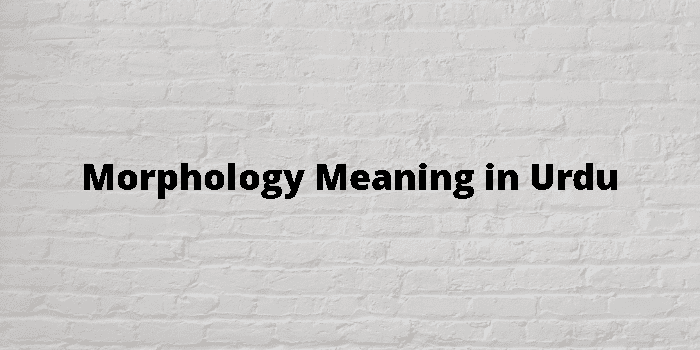لسانیاتی تناظر میں اردو مارفیمیات: ایک تحقیقی مطالعہ
Keywords:
Morphology, Morphemes, Linguistics, Word Structure, Derivational MorphemesAbstract
Morphology, or Morphemics, is a crucial branch of linguistics that focuses on the study of the structure of words and how they are formed. A morpheme, which is the smallest meaningful unit in a language, plays a vital role in this field. It can either be free, meaning it stands alone as a word, like "house," or bound, meaning it must be attached to another morpheme, as in the case of "ness" in "kindness." Morphemes are broadly categorized into two types: inflectional and derivational. Inflectional morphemes modify a word to convey grammatical information such as tense, number, or gender without altering its core meaning, whereas derivational morphemes create entirely new words by changing the meaning or grammatical category of the base word, such as turning "happy" into "happiness."
Scholars such as Iqtadar Hussain, Naseer Ahmad, Khalil Ahmad Saddique, A.S Saddique, and Ali Rafad Fathi have contributed significantly to the exploration of morphemic structures and their significance in various languages. Their work has enriched the understanding of how morphemes function in shaping the syntax and semantics of a language. In the context of Urdu, the study of morphology reveals how words are systematically constructed through prefixes, suffixes, and infixes, following principles similar to those found in other languages. Understanding morphemes and their role in word formation not only aids in linguistic analysis but also provides insight into the historical and cultural evolution of language structures. It helps in exploring the dynamic nature of languages and the ongoing development of vocabulary and grammar.
Downloads
References
۱ گیان چند جین، ڈاکٹر ، ’’عام لسانیات‘‘، ترقی اردو بیورو، نئی دہلی، ۱۹۷۵ء ، ص:۱۹۳
۲ عتیق احمد صدیقی، ’’توضیحی لسانیات (ایک تعارف)‘‘, قومی کونسل برائے فروغِ اردو زبان، نئی دہلی، ۱۹۷۸ء ، ص :۶۲
۳ Website: Cambridge Dictionary مورخہ ۱۲ اکتوبر ۲۰۲۰، وقت ۳۰:۸ شام
۴ علی رفاد فتحی، ’’اردو لسانیات‘‘ ،قومی کونسل برائے فروغِ اردو زبان، نئی دہلی، ۲۰۱۳ء، ص:۹۳
۵ خلیل احمد صدیقی،’’لسانی مباحث‘‘ ، زمرد پبلی کیشنز، کوئٹہ، ۱۹۹۱ء، ص:۲۰۴
۶ Website: Oxford Dictionary ،مورخہ ۱۳ اکتوبر ۲۰۲۰، وقت: ۶:00 شام
۷ گیان چند، ڈاکٹر ،’’عام لسانیات‘‘، ترقی اردو بیورو ، نئی دہلی، ۱۹۷۵ء ، ص:۲۰۰
۸ ایضاً،ص:۲۰۰
۹ Website: Cambridge Dictionary مورخہ ۱۳ اکتوبر ۲۰۲۰، وقت: ۱:00 دوپہر
۱۰ گیان چند جین، ڈاکٹر، ’’عام لسانیات‘‘، ترقی اردو بیورو، نئی دہلی، ۱۹۷۵ء ، ص:۲۱۰
۱۱ ایضاً،ص:۲۱۱
۱۲ علی رفاد فتحی، ’’اردو لسانیات‘‘،قومی کونسل برائے فروغِ اردو زبان، نئی دہلی، ۲۰۱۳ء، ص:۱۲
۱۳ ایضاً, ص:۹۳
۱۴ نصیر احمد خان،’’اردو ساخت کے بنیادی عناصر‘‘، اردو محل پبلی کیشنز، دہلی، ۱۹۹۱ء، ص: ۳۴
۱۵ اقتدار حسین خان، ’’اردو صرف و نحو‘‘،ترقی اردو بیورو، نئی دہلی ، ۱۹۸۵ء ص:۲۱۱
۱۶ خلیل احمد صدیقی، ’’لسانی مباحث‘‘، زمرد پبلی کیشنز، کوئٹہ، ۱۹۹۱ء ، ص:۲۰۴
۱۷ ایضاً، ص:۲۰۵
۱۸ ایضاً،ص:۲۰۷
۱۹ ایضاً,،ص:۲۰۸
۲۰ ایضاً، ص:۲۰۹
۲۱ ابواللیث صدیقی، ڈاکٹر ’’جامع القواعد‘‘، مکتبہ جدید پریس، لاہور، ۱۹۱۱، ص:۲۲۵
۲۲ ایس اے صدیقی،’’ادب اور لسانیات‘‘، ادارہ اشاعت اردو، بھوپال، ۱۹۹۱ء، ص:۱۱
References
Jain, G. C. (1975). Aam Lisanayat [General Linguistics]. Development Urdu Bureau, New Delhi, p. 193.
Siddiqui, A. A. (1978). Tawzeeh-i Lisanayat (Ik Taaruf) [Explanatory Linguistics (An Introduction)]. National Council for the Promotion of Urdu Language, New Delhi, p. 62.
Cambridge Dictionary. (2020, October 12). Retrieved at 8:30 PM from https://www.cambridge.org/dictionary
Fathi, A. R. (2013). Urdu Lisanayat [Urdu Linguistics]. National Council for the Promotion of Urdu Language, New Delhi, p. 93.
Siddiqui, K. A. (1991). Lisan-i Mubahas [Linguistic Discussions]. Zamarad Publications, Quetta, p. 204.
Oxford Dictionary. (2020, October 13). Retrieved at 6:00 PM from https://www.oxforddictionary.com
Jain, G. C. (1975). Aam Lisanayat [General Linguistics]. Development Urdu Bureau, New Delhi, p. 200.
Ibid., p. 200.
Cambridge Dictionary. (2020, October 13). Retrieved at 1:00 PM from https://www.cambridge.org/dictionary
Jain, G. C. (1975). Aam Lisanayat [General Linguistics]. Development Urdu Bureau, New Delhi, p. 210.
Ibid., p. 211.
Fathi, A. R. (2013). Urdu Lisanayat [Urdu Linguistics]. National Council for the Promotion of Urdu Language, New Delhi, p. 12.
Ibid., p. 93.
Khan, N. A. (1991). Urdu Saakht ke Bunyadi Ansar [Basic Elements of Urdu Structure]. Urdu Mahal Publications, Delhi, p. 34.
Khan, I. H. (1985). Urdu Sarf-o-Nahv [Urdu Morphology and Syntax]. Development Urdu Bureau, New Delhi, p. 211.
Siddiqui, K. A. (1991). Lisan-i Mubahas [Linguistic Discussions]. Zamarad Publications, Quetta, p. 204.
Ibid., p. 205.
Ibid., p. 207.
Ibid., p. 208.
Ibid., p. 209.
Siddiqui, A. B. (1911). Jami'-ul-Qawa'id [Comprehensive Grammar]. Maktabah Jadeed Press, Lahore, p. 225.
Siddiqui, S. A. (1991). Adab aur Lisanayat [Literature and Linguistics]. Idara-e-Ishaat Urdu, Bhopal, p. 11.

Downloads
Published
Issue
Section
License
Copyright (c) 2024 Scholar Insight Journal

This work is licensed under a Creative Commons Attribution-NonCommercial-NoDerivatives 4.0 International License.
Authors retain the copyright of their work. All articles in Scholar Insight Journal are published under the terms of the Creative Commons Attribution 4.0 International License (CC BY 4.0).
This license permits anyone to read, download, copy, distribute, print, search, or link to the full texts of the articles, and to use them for any other lawful purpose, without asking prior permission from the author(s) or the publisher, provided proper attribution is given to the original work.




